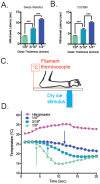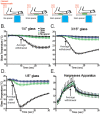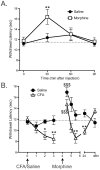A novel behavioral assay for measuring cold sensation in mice
- PMID: 22745825
- PMCID: PMC3382130
- DOI: 10.1371/journal.pone.0039765
A novel behavioral assay for measuring cold sensation in mice
Abstract
Behavioral models of cold responses are important tools for exploring the molecular mechanisms of cold sensation. To complement the currently cold behavioral assays and allow further studies of these mechanisms, we have developed a new technique to measure the cold response threshold, the cold plantar assay. In this assay, animals are acclimated on a glass plate and a cold stimulus is applied to the hindpaw through the glass using a pellet of compressed dry ice. The latency to withdrawal from the cooled glass is used as a measure of the cold response threshold of the rodents, and the dry ice pellet provides a ramping cold stimulus on the glass that allows the correlation of withdrawal latency values to rough estimates of the cold response threshold temperature. The assay is highly sensitive to manipulations including morphine-induced analgesia, Complete Freund's Adjuvant-induced inflammatory allodynia, and Spinal Nerve Ligation-induced neuropathic allodynia.
Conflict of interest statement
Figures





References
-
- Tanabe P, Buschmann M. A prospective study of ED pain management practices and the patient's perspective. Journal of Emergency Nursing. 1999;25:171–177. - PubMed
-
- Medicine Io. Relieving Pain In America: A Blueprint for Transforming Prevention, Care, Education, and Research. Institute of Medicine. 2011. - PubMed
-
- Svendsen KB, Jensen TS, Hansen HJ, Bach FW. Sensory function and quality of life in patients with multiple sclerosis and pain. Pain. 2005;114:473–481. - PubMed
-
- Cassidy J, Misset JL. Oxaliplatin-related side effects: characteristics and management. Seminars in oncology. 2002;29:11–20. - PubMed
Publication types
MeSH terms
Grants and funding
LinkOut - more resources
Full Text Sources
Other Literature Sources
Medical

